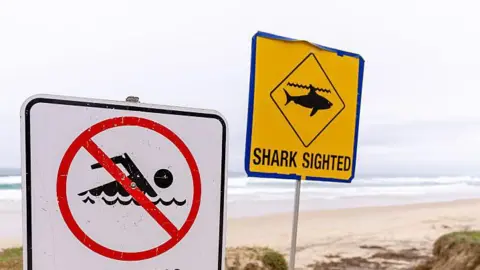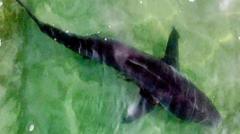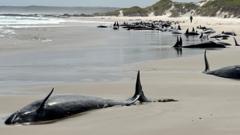Mauricio Hoyos still remembers the pressure that the jaws of a female Galapagos shark, over 3m (10ft) in length, exerted on his skull.
The animal had lunged at him with astonishing speed, giving him barely enough time to duck his head in a last ditch effort to protect his jugular vein.
When it closed its jaw, I felt the pressure of the bite, and then, after what I think was a second, it opened it again and it let me go, Hoyos told BBC Mundo from his home in Baja California, Mexico, a little over month after surviving the incident.
Hoyos, a marine biologist with over 30 years of experience studying sharks in their natural habitat, was on a research trip in Costa Rica when he was attacked by the shark in September.
Less than two months on, and still bearing the scars from the attack on his face, he describes his recovery as incredible - and says he even hopes to encounter his assailant again.
For Hoyos, what happened to him that day in the waters off Cocos Island is the result of normal animal behaviour when confronted with a perceived threat.
In this case, this bite was like a dog's, he says.
Have you ever seen how dogs, when another dog gets too close, throw a quick bite? It doesn't hurt it, but it calms the other dog down. Hoyos - who along with his colleagues attaches acoustic tags to sharks to help pinpoint their mating and spawning grounds as part of his work - was alerted to the shark's presence in the water by tourists.
He then entered the water and began his slow descent, planning to stay for only five minutes.
Hoyos recalls encountering the shark: This giant female, measuring between 3 and 3.5m (11.5ft), swam by and headed toward the bottom, and I positioned myself to tag her at the base of her dorsal fin. But the shark reacted differently than ones he had tagged before.
Obviously the tip - the metal tip attached to the cable hanging from the probe - goes in, and unlike the other sharks I've tagged that immediately flee, she turns around and stares at me. Then, suddenly, it lunged at him.
He held the shark's gaze as it swam away, but then, out of nowhere, it attacked. I lowered my head, and what I felt was its lower jaw digging into my cheek and its upper jaw into my head. I was there, I imagine for a second, no more, inside its jaw, and then it simply opened it again.
The shark's teeth left deep wounds to Hoyos's face and severed oxygen lines of his diving apparatus, putting him in a perilous situation. He recounted his harrowing struggle to the surface as he dealt with bleeding injuries and malfunctioning equipment.
After reaching the surface, he received immediate medical attention and underwent surgery, recovering remarkably well with minimal complications.
Hoyos, undeterred by his experience, is booking another diving trip to the same location where he hopes to see the shark again and advocate for shark conservation.
This is the proof that this female spared my life; I can't put it any other way. And this will allow me to continue speaking well of sharks and advocating for their conservation in the future.


















